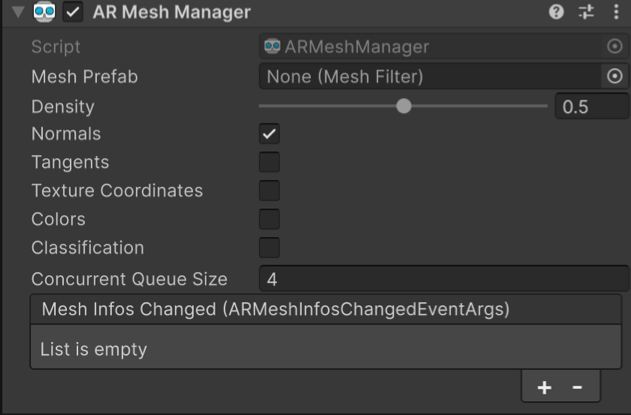AR Mesh Manager component
Learn about the AR Mesh Manager component.
The AR Mesh Manager enables and configures meshing functionality on supported platforms.
Get started
To use meshing with AR Foundation, add the AR Mesh Manager component to a child GameObject of your scene's XR Origin. If your scene doesn't contain an XR Origin GameObject, first follow the Scene setup instructions.
Configure meshing properties
Use the AR Mesh Manager to configure meshing properties in your project.
To access the AR Mesh Manager properties, select the GameObject that contains your AR Mesh Manager from the Hierarchy window and view it in the Inspector.

AR Mesh Manager component in the Inspector.
Component reference
The AR Mesh Manager enables you to configure the following options:
| Property | Description |
|---|---|
| Mesh Prefab | The prefab that's instantiated for each scanned mesh. Refer to Set the mesh prefab for more information. |
| Density | Specifies the amount of tessellation to perform on the generated mesh. |
| Normals | If enabled, a normal is requested for each vertex. |
| Tangents | If enabled, a tangent is requested for each vertex. |
| Texture Coordinates | If enabled, a texture coordinate is requested for each vertex. |
| Colors | If enabled, a color value is requested for each vertex. |
| Concurrent Queue Size | Specifies the number of meshes to process concurrently. |
| Classification | If enabled, classifications are made available for mesh subcomponents. Refer to Mesh classification for more information about the mesh classification feature. |
| Mesh Infos Changed (ARMeshInfosChangedEventArgs) | Invoked when meshes have changed (been added, updated, or removed). |
Note
Not all properties are available on all platforms. Refer to Meshing platform support to learn more.
Mesh prefab
You must set the mesh prefab as outlined in Set the mesh prefab.
Density
The density property, in the range 0 to 1, specifies the amount of tessellation to perform on the generated mesh. A value of 0 results in the least amount tessellation, whereas a value of 1 produces the most tessellation.
Normals
When the device is constructing the mesh geometry, it might calculate the vertex normals for the mesh. If you don't need the mesh vertex normals, disable normals to save on memory and CPU time.
Tangents
When the device is constructing the mesh geometry, it might calculate the vertex tangents for the mesh. If you don't need the mesh vertex tangents, disable tangents to save on memory and CPU time.
Texture coordinates
When the device is constructing the mesh geometry, it might calculate the vertex texture coordinates for the mesh. If you don't need the mesh vertex texture coordinates, disable textureCoordinates to save on memory and CPU time.
Colors
When the device is constructing the mesh geometry, it might calculate the vertex colors for the mesh. If you don't need the mesh vertex colors, disable colors to save on memory and CPU time.
Concurrent queue size
To avoid blocking the main thread, the tasks of converting the device mesh into a Unity mesh and creating the physics collision mesh (if the meshPrefab's GameObject contains a MeshCollider component) are moved into a job queue processed on a background thread. concurrentQueueSize specifies the number of meshes to be processed concurrently.
Mesh classification
In AR Foundation 6.4 and newer, you can enable mesh classification on supported platforms. To learn more, refer to Mesh classification.